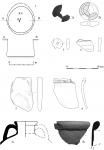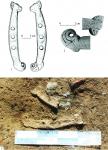Summary (English)
During the season of 2011, the expedition worked on two areas of the hillfort.
First, it is the Southern excavation site where earthwork was held since 2009. A stone pavement was uncovered alongside the rampart’s inner slope for 15 m. According to this, the researchers suppose that it was not an accidental feature but an integral part of the fortification structure. A lot of cultural debris together with a lot of burned clay pieces were detected at the hillfort’s inner area at the level of the stone pavement. Handmade pottery, mostly black-glazed bowls and pot rims decorated with punctures, constituted the majority of the finds. But also clay zoomorphic figurines and miniature clay “bread loaf” draw attention. Also, a lot of burned clay pieces were deposited on this level.
Second, it is the South-Western excavation site placed alongside the precipice that constantly destroys the hillfort. There was no cultural layer detected here but partly destroyed household pits were seen at the eroded slopes.
Pit 3 was distinguished by a black-glazed cylindrical vessel that looks like a pyxis.
Pit 4 is very interesting because the only known amphora rim was found in it. It is the archaic Samos type that could be dated by the early-mid. 6th c. BC. A pair of broken psalia decorated in the Scythian animal style also looks interesting because it is a unique case when a set of them was found at a settlement. Their ornamentation is unique as each end of the psalia ends with a carved head of the beast. A model of the broken clay altar with circular ornament is another unusual find from this pit.
Object 5 was a pit filled with ash and cultural debris. A lot of pottery shreds were laid on the bottom of it There are the typical cooking pots, big storage jars and so-called cauldron-shaped pots all of which are ornamented mostly in the same way. However, the wall of one of the storage jars was decorated with smooth cannelures in a form of semicircles.
Pit 5 was a small smooth cavity at the buried surface that contained a little amount of the finds.
Pit 6 contained a lot of pottery fragments at the lower level. A black-glazed bowl and two half-restored cooking pots are among them. The upper part of the pit was filled with a dumped burned clay, perhaps pieces of the destroyed hut walls.
All collected material lay within the mid. 7th – mid 6th centuries BC.
- Shelekhan Oleksandr - Institute of Archaeology, National Academy of Sciences of Ukraine
Director
- Marcin Ignaczak - Adam Mickiewicz University in Poznan
- Yuriy Boltryk - Institute of Archaeology, National Academy of Sciences of Ukraine
Team
- Oksana Lifantii - National University of Kyiv-Mohyla Academy
- Shelekhan Oleksandr - Institute of Archaeology, National Academy of Sciences of Ukraine
Research Body
- Institute of Archaeology, National Academy of Sciences of Ukraine
- Instytut Prahistorii Uniwersytet im. Adama Mickiewicza w Poznaniu






![Download [PDF]](/excavation/skins/fasti/images/results/download_sml.png)



